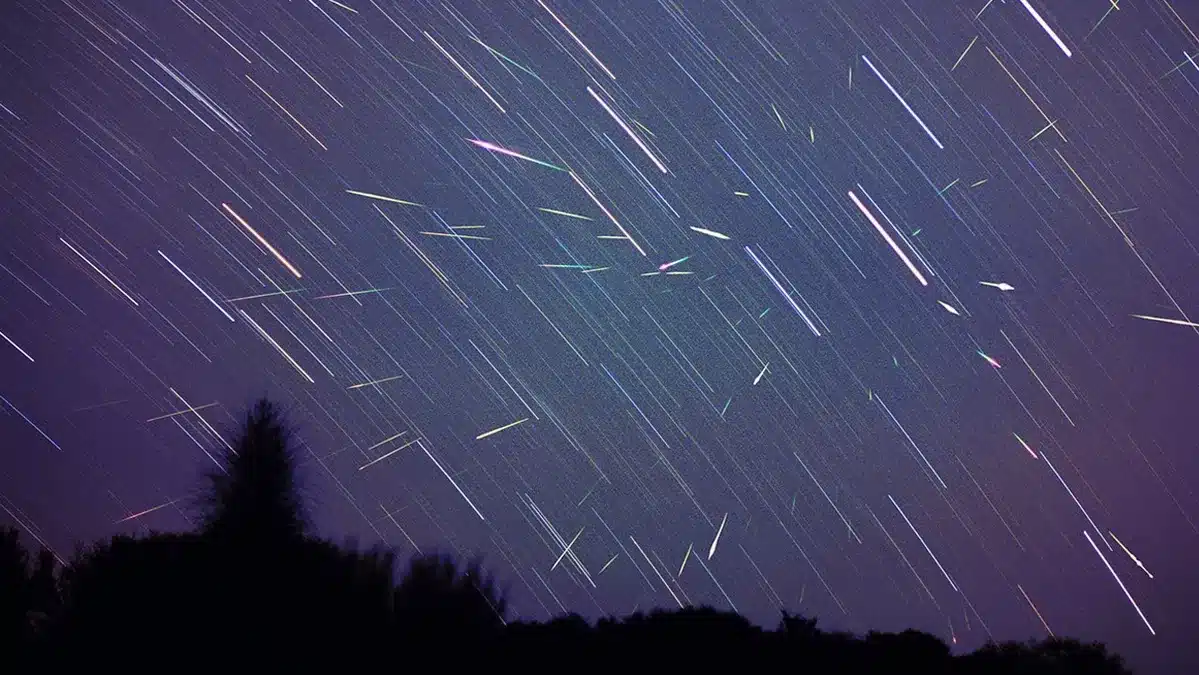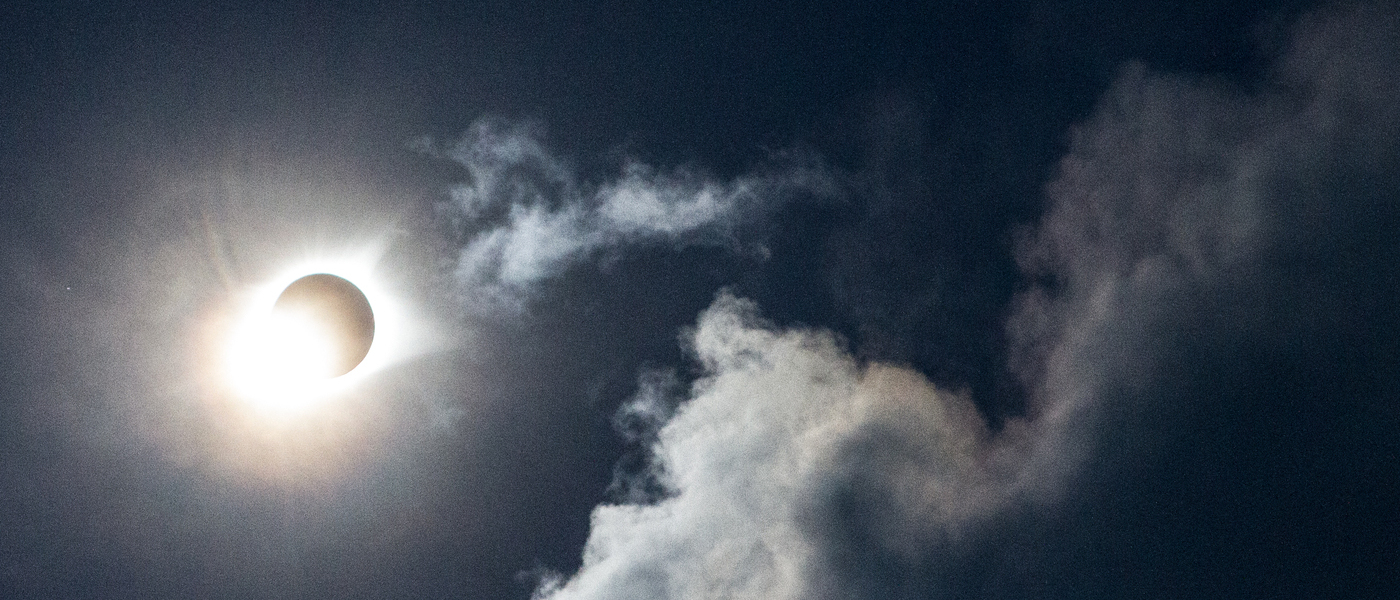Science
Keep An Eye On The Sky For The Leonid Meteor Shower This Weekend Peak On The 18th

The Leonid meteor shower, expected to deliver brilliant meteors with persistent trains shooting across the night sky, is next for end-of-year celestial spectaculars.
According to EarthSky, the Leonids have been active since early November and are scheduled to peak this weekend at 12:33 a.m. ET Saturday. Skywatchers could witness 10 to 15 meteors each hour in a spectacular display.
Those hoping to see a meteor from this shower are in luck because the moon will be in its waxing crescent phase, which means there will be less light interference than there is with a full moon, according to Dr. Sharon Morsink, a professor of physics at the University of Michigan.
The University of Alberta is located in Edmonton, Alberta. According to the American Meteor Society, the moon will be 23% full on the night of the shower’s peak.
While Saturday is the peak, the same rates of meteors can be seen a few days before and after. According to Morsink, who also administers the university’s astronomical observatory, the optimum time to view the shower would be after midnight in any time zone when the constellation Leo will be highest in the sky.
The Leonid meteor showers
She said that Leo is the radiant of the meteor shower, which is where the event appears to start.
“The most important thing is to avoid light pollution,” Morsink said. “You can still see some meteors if you’re in the city, but you’re not going to see anywhere near the number you get to see if you get out of the city.”
According to NASA, the Leonids are famous for producing meteor storms, which occur when a shower produces at least 1,000 meteors per hour.
According to the American Meteor Society, the Leonids generated 144,000 meteors per hour in 1966, setting the record for the highest number of meteors per hour witnessed in a meteor stream. The shower also produced higher-rate outbursts in 1999 and 2001, but humanity does not anticipate another storm until 2099, when the Earth is expected to collide with a dense cloud of debris from the parent comet, Tempel-Tuttle.
As the comet orbits the sun, it leaves a trail of pebbles and dust behind it, which causes the yearly Leonid meteor shower to occur as Earth passes through the debris on its orbital path.
Although a Leonid storm event is not expected this year, there is always the possibility of seeing a few more meteors than the estimated rate, according to Morsink.
“Getting out and seeing any meteor shower for the first time is always fun,” she said. “It’s just this fascinating connection we have with the entire solar system — here’s this comet far away from us that has been circling the sun for an incredibly long time, probably billions of years.” It allows us to communicate with objects that are quite far away.”
Keep An Eye On The Sky For The Leonid Meteor Shower This Weekend
According to the American Meteor Society, meteors from the Leonids are expected to be blazing in the sky until the shower’s finality on December 2.
If you are eager to see more, here are the remaining meteor showers that peak in 2023:
● Geminids: December 13-14
● Ursids: December 21-22
Full moons
There are two full moons remaining in 2023, according to the Farmers’ Almanac:
● November 27: Beaver moon
● December 26: Cold moon
The Leonid meteors are a prolific meteor shower associated with the comet Tempel-Tuttle. They are visible annually in November when the Earth passes through the debris trail left by the comet. The meteors appear to radiate from the constellation Leo, hence their name.
At their peak, the Leonids can produce a high number of meteors per hour, known as a meteor storm. This celestial event is popular among stargazers and astronomers due to the impressive display of bright, fast-moving meteors.
SOURCE – (CNN)
News
China Launches Long March-5 to the “Dark Side of Moon”

China has launched an unmanned spacecraft on a nearly two-month journey to gather rocks and soil from the moon’s far side, becoming the first country to undertake such an ambitious task.
China’s heaviest rocket, the Long March-5, lifted off at 5:27 p.m. Beijing time (0927 GMT) from the Wenchang Space Launch Center on the southern island of Hainan, carrying the Chang’e-6 probe weighing more than 8 metric tons.
China’s Chang’e-6 is entrusted with landing in the South Pole-Aitken Basin on the moon’s far side, which is continuously facing away from Earth, and retrieving and returning samples.
The launch is another significant milestone in China’s lunar and space exploration mission.
“It is a bit of a mystery to us how China has been able to develop such an ambitious and successful programme in such a short time,” said Pierre-Yves Meslin, a French researcher working on one of the Chang’e-6 mission’s scientific objectives.
In 2018, Chang’e-4 made China’s first unmanned moon landing on the far side. Chang’e-5 returned lunar samples for the first time in 44 years in 2020, and Chang’e-6 has the potential to make China the first country to retrieve samples from the moon’s “hidden” side.
Scientists, diplomats, and space agency officials from France, Italy, Pakistan, and the European Space Agency all attended the launch, which carried moon-study payloads on Chang’e-6.
However, no US groups requested for a payload place, according to Ge Ping, deputy director of the China National Space Administration’s (CNSA) Lunar Exploration and Space Program.
U.S. law prohibits China from collaborating with the United States’ space agency, NASA.
The Dark Side of the Moon
The far side of the moon, also known as the “dark side of the moon” despite receiving sunlight, is the hemisphere that always faces away from Earth. The Soviet Luna 3 spacecraft made the first observation of this strange region in 1959.
Unlike the near side, the far side lacks enormous, dark basins known as marias. Instead, hundreds of craters produced by asteroid collisions over billions of years blanket it.
The South Pole-Aitken Basin, an immense crater more than 1,500 miles wide and several miles deep, is one of the most visible landforms on the far side. This ancient impact basin is among the largest known crater formations in our solar system. The far side likewise has many mountains, ridges, and other harsh topography formed by cosmic collisions.
Studying the far side provides insights into the moon’s genesis and early history because it maintains impact records from the solar system’s turbulent childhood.
Scientists also intend to investigate it for potential resources and future lunar bases. With no atmosphere or magnetic field, the far side displays the wounds of endless meteor bombardments, exposing information about Earth’s only natural satellite that the near side lacks.
Source: Reuters
Apple Boss Tim Cook Makes Surprise China Visit
Business
What Marijuana Reclassification Means For The United States

Washington — The United States Narcotic Enforcement Administration is considering reclassifying marijuana as a less harmful narcotic. The Justice Department’s proposal would recognize cannabis’ medical purposes but not legalize it for recreational use.
The proposal would shift marijuana from the “Schedule I” category to the less stringent “Schedule III.”
So, what does this mean, and what are the implications?
Technically, nothing has happened. The White House Office of Management and Budget must first examine the idea, followed by a public comment period and an administrative judge’s assessment, which could be a lengthy process.
Nonetheless, the change is considered “paradigm-shifting, and it’s very exciting,” Vince Sliwoski, a Portland, Oregon-based cannabis and psychedelics attorney who runs well-known legal blogs on those topics, told The Associated Press when the federal Health and Human Services Department recommended it.
AP – VOR News Image
What Marijuana Reclassification Means For The United States
“I can’t emphasize enough how big of news it is,” he said.
It came after President Joe Biden last year requested that HHS and the attorney general, who controls the DEA, investigate how marijuana was classified. Schedule I legalized it alongside heroin, LSD, quaaludes, and ecstasy, among other substances.
Biden, a Democrat, is in favor of legalizing medical marijuana “where appropriate, consistent with medical and scientific evidence,” White House press secretary Karine Jean-Pierre said on Thursday. “That is why it is important for this independent review to go through.”
No. Schedule III medicines, such as ketamine, anabolic steroids, and several acetaminophen-codeine combos, are still considered controlled narcotics.
AP – VOR News Image
What Marijuana Reclassification Means For The United States
They are subject to a variety of restrictions that allow for some medical usage as well as federal criminal punishment of anyone who traffics in the medications illegally.
Medical marijuana programs, which are already regulated in 38 states, and legal recreational cannabis markets in 23 states are expected to remain unchanged, but they are unlikely to meet federal production, record-keeping, prescribing, and other Schedule III drug criteria.
There haven’t been many federal prosecutions for simply possessing marijuana in recent years, even with marijuana’s existing Schedule I designation, but reclassification would have no immediate impact on those currently in the criminal justice system.
“Put simply, this shift from Schedule I to Schedule III is not keeping people out of jail,” said David Culver, senior vice president of public relations of the United States Cannabis Council.
However, rescheduling would have an impact, especially on research and marijuana business taxes.
Because marijuana is classified as a Schedule I substance, it has been extremely difficult to undertake permitted clinical trials involving its administration. This has produced a Catch-22 situation: there is a need for further study, but there are hurdles to doing so. (Sometimes, scientists rely on people’s claims of marijuana use.)
Schedule III medications are easier to study, although reclassification would take time to remove all hurdles to research.
“It’s going to be really confusing for a long time,” says Ziva Cooper, director of the University of California, Los Angeles Center for Cannabis and Cannabinoids. “When the dust has settled, I don’t know how many years from now, research will be easier.”
Among the unknowns include whether academics will be permitted to study marijuana from state-licensed shops and how the federal Food and Drug Administration would regulate this.
Some researchers remain optimistic.
“Reducing the schedule to schedule 3 will allow us to conduct research with human subjects using cannabis,” said Susan Ferguson, director of the University of Washington’s Addictions, Drug, and Alcohol Institute in Seattle.
Firms involved in “trafficking” marijuana or any other Schedule I or II substance are not allowed to deduct rent, payroll, or other expenses that other firms can. (Yes, despite the federal government’s prohibition on marijuana, at least some cannabis firms, particularly those permitted by states, pay federal taxes.) According to industry associations, tax rates frequently reach 70% or more.
The deduction regulation does not apply to Schedule III medications, so the proposed amendment would significantly reduce cannabis companies’ taxes.
They claim it would treat them like other industries and let them compete with unlawful competitors that frustrate licensees and officials in locations like New York.
“You’re going to make these state-legal programs stronger,” says Adam Goers, an executive at Columbia Care, a medicinal and recreational cannabis provider. He co-chairs a group of corporate and other stakeholders advocating for rescheduling.
According to Beau Kilmer, co-director of the RAND Drug Policy Center, deducting those expenditures could result in greater cannabis marketing and advertising.
Rescheduling would have no direct impact on another marijuana business issue: limited access to banks, particularly for loans, due to federally regulated institutions’ concerns about the drug’s legal status. Instead, the sector has focused on the SAFE Banking Act. It has frequently passed the House but is stuck in the Senate.
AP – VOR News Image
What Marijuana Reclassification Means For The United States
Yes, there are, notably the national anti-legalization organization Smart Approaches to Marijuana. President Kevin Sabet, a former Obama administration drug policy official, said the HHS suggestion “flies in the face of science, reeks of politics” and gives a disappointing nod to an industry “desperately looking for legitimacy.”
Some legalization supporters argue that rescheduling marijuana is too modest. They want to keep the focus on totally removing it from the controlled substances list, which does not include alcohol or tobacco (although they are regulated).
According to Paul Armentano, deputy director of the National Organization for the Reform of Marijuana Laws, simply reclassifying marijuana would be “perpetuating the existing divide between state and federal marijuana policies.” According to Kaliko Castille, President of the Minority Cannabis Business Association, rescheduling simply “re-brands prohibition,” rather than giving state licensees the green light and bringing an end to decades of arrests that disproportionately affected people of color.
“Schedule III is going to leave it in this kind of amorphous, mucky middle where people are not going to understand the danger of it still being federally illegal,” the senator stated.
Peltz reported from New York. Associated Press writers Colleen Long in Washington and Carla K. Johnson in Seattle contributed to this story.
SOURCE – (AP)
Science
How To Tell If You Have Eye Damage After Viewing The Eclipse

Eye balls bugging you after watching the eclispe? The solar eclipse passed over Mexico, the United States, and Canada on Monday, providing a heavenly show. However, in the aftermath, some people may experience eye irritation instead of astonishment.
You may be wondering if your eclipse glasses were bogus. Perhaps you neglected to put them back on as the day’s first rays arrived after totality. Or you spotted your child, friend, or family member looking up at the sun without wearing glasses.
How To Tell If You Have Eye Damage After Viewing The Eclipse
Solar retinopathy, or retinal damage brought on by solar radiation, can result from looking at the sun without using appropriate eye protection, such as certified eclipse glasses or solar viewers. While the highly specialized cells inside our eyes do not experience pain, staring at the sun causes inflammation and damage to the rods, cones, and photochemical reactors, according to Ronald Benner, an optometrist and president of the American Optometric Association.
During the 2017 total solar eclipse, a young woman was diagnosed with solar retinopathy in both eyes after viewing it with eclipse glasses that physicians said were not up to safety standards.
There is no cure for solar retinopathy. It may improve or worsen, but it is a permanent condition.
After-eclipse eye injury symptoms
Symptoms of eye injury from viewing the eclipse without proper protection can take hours or days to appear. They include loss of central vision, changes in color vision, and distorted vision.
How To Tell If You Have Eye Damage After Viewing The Eclipse
“Eclipse damage is unlikely to produce pain or discomfort in your eyes because the retina lacks pain nerves. Instead, visual symptoms might appear within 4-6 hours. However, some people may experience symptoms after 12 hours,” emailed Michelle Andreoli, eye ophthalmologist and clinical representative for the American Academy of Ophthalmology.
Doctors advise that if you detect any signs or are experiencing eye discomfort, schedule an appointment with a health care provider or an eye care specialist right away.
“For most people, it’s an alteration of color vision,” he stated. “The next morning, the colors don’t appear right, or they’ve been bleached out or fuzzy all the time. Others may have genuine holes in their vision.
According to Benner, damage to the center of someone’s eyesight can impair their ability to read or recognize faces.
It is comparable to the effect a camera flash has on our eyes, which can distort it for a few minutes before going away. However, the severity of solar retinopathy causes lifelong damage that is not immediately noticeable. Overnight, the cells can perish and will not be replaced.
How To Tell If You Have Eye Damage After Viewing The Eclipse
The injury sustained determines the alterations in a person’s vision, which can occur in one or both eyes.
“The retina is an extension of the brain, so it’s actually neurological tissue, and when you damage that, it doesn’t always come back,” he said. “If you harm one cell, it may never be the same. However, if you damage a group of cells, you will experience blotchy vision, similar to having someone rub oil on your windshield. If you only cause little damage to them and do not kill them, their color vision will be affected. What can you do about this? Nothing else than preventing it.”
Benner also recommends that parents discuss with their children the signs of pain if they watched the eclipse together, especially if they are concerned that their children may have removed or glanced around the eclipse glasses. Children may find it difficult to explain their experiences, such as not being able to properly see
SOURCE – (CNN)
-
Sports5 months ago
Saints’ Aggressive Play-Calling Ends Up Coming Back To Hurt Them In Loss To Rams
-
Business5 months ago
Nike Says It Will Cut $2 Billion In Costs In A Major Warning For Consumers
-
Politics5 months ago
Claudine Gay: Harvard President Won’t Lose Job Over Congress Row
-
Business5 months ago
Federal Court Revives Lawsuit Against Nirvana Over 1991 ‘Nevermind’ Naked Baby Album Cover
-
News4 months ago
The Rise of Woke Ideology in Western Culture
-
Learning5 months ago
POLG Mutations and Its Impact on Children’s’ Health

















































